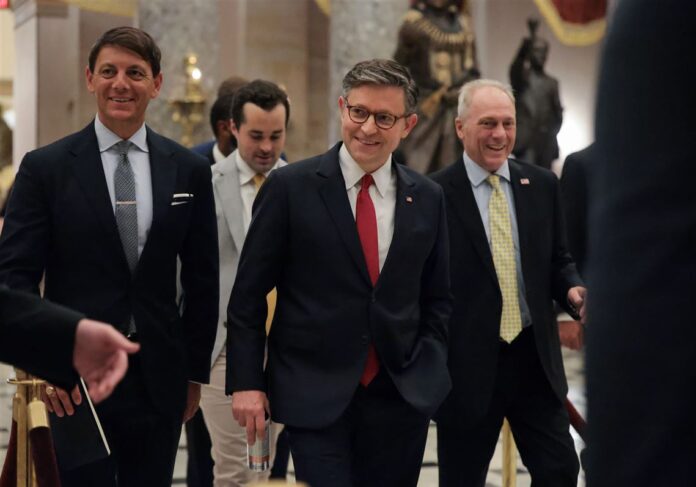As of July 3, 2025, the question on everyone’s mind in Washington and across the nation is: Did the Big Beautiful Bill pass? President Donald Trump’s sweeping legislative package, known as the “Big Beautiful Bill,” has dominated headlines as lawmakers race against a self-imposed July 4 deadline to deliver a signature win for the administration. This comprehensive bill, which includes major tax cuts, deep Medicaid reductions, and aggressive immigration enforcement, has faced fierce debate, last-minute negotiations, and high-stakes political drama.
Did the Big Beautiful Bill Pass? The Latest Developments
On the morning of July 3, the House of Representatives was poised for a final, decisive vote on the Big Beautiful Bill. After clearing a crucial procedural hurdle in the early hours, House Republican leaders announced they had secured the votes needed to move the bill forward. Speaker Mike Johnson, flanked by security and staff, made his way to the Capitol, signaling confidence that the legislation would pass after a lengthy standoff with a small but vocal group of conservative holdouts.
The bill had already passed the Senate on July 1, with a razor-thin 51-50 vote, Vice President JD Vance casting the tie-breaker after three Republican senators dissented. The House, having previously passed its own version by a single vote (215-214) in May, faced renewed opposition from fiscal conservatives who objected to the bill’s cost and deficit impact after Senate amendments increased spending. Despite these concerns, Johnson and his team worked through the night, keeping the procedural vote open for over five hours—the longest in House history—to wrangle enough support.
Key Point Summary
- Senate Passage: Bill cleared the Senate on July 1, 51-50, with VP Vance breaking the tie.
- House Procedural Hurdle: Passed early July 3 after hours-long standoff with GOP holdouts.
- Final House Vote: Scheduled for the morning of July 3, with leaders confident of passage.
- Bill Contents: Massive tax cuts, Medicaid reductions, expanded immigration enforcement, and incentives for manufacturing and business.
- Democratic Opposition: Minority Leader Hakeem Jeffries used the “magic minute” to delay proceedings and spotlight opposition.
Read also-Big Beautiful Bill Social Security: Major 2025 Relief for Seniors
What Trump Promised GOP Hardliners to Secure Votes
To win over skeptical conservatives, President Trump and House leaders offered a mix of policy concessions and personal outreach. Trump personally contacted dissenting lawmakers, emphasizing the bill’s benefits—calling it the “Largest Tax Cuts in History” and a driver of economic growth. He promised that the legislation would:
- Eliminate taxes on tips and overtime
- Permanently extend business tax cuts
- Increase immediate write-offs for new manufacturing plants
- Enhance tax credits for domestic semiconductor production
- Boost deductions for small business owners and partnerships
Despite these assurances, some hardliners remained concerned about the bill’s impact on the national debt and the perceived insufficiency of federal spending cuts. Ultimately, the pressure campaign—including Trump’s public rebukes on social media—swayed enough holdouts to advance the bill.
House Minority Leader Jeffries Uses “Magic Minute” to Delay Vote
As the House prepared for the final vote, Minority Leader Hakeem Jeffries took to the floor, employing the “magic minute” rule to extend debate and voice Democratic opposition. Jeffries branded the bill an “all-out assault” on Americans’ health and living standards, reading letters from constituents who rely on Medicaid and other social programs facing cuts. This move delayed proceedings by several hours but did not prevent the bill from advancing.
House Speaker Johnson and GOP Dissent
Speaker Mike Johnson faced a delicate balancing act, needing nearly unanimous GOP support due to the party’s slim majority. Pennsylvania Rep. Brian Fitzpatrick and several other conservatives wavered, citing concerns over spending and the bill’s complexity. Johnson’s decision to keep the vote open for hours, combined with Trump’s direct appeals, ultimately secured the needed votes. Johnson described the process as “exactly how the framers envisioned it functioning,” highlighting the intensity and stakes of the legislative battle.
Who Wins and Who Loses Under the Big Beautiful Bill?
The Big Beautiful Bill is set to reshape the American economic and social landscape:
Winners:
- Corporations: Permanent tax reductions and incentives for new manufacturing.
- Small Businesses: Larger deductions for pass-through entities.
- Manufacturers: Immediate write-offs for new plant construction.
- High-Income Earners: Significant tax relief on tips, overtime, and investment income.
Losers:
- Medicaid Recipients: Deep funding cuts threaten health coverage for millions.
- Clean Energy Sector: Reduced federal investment in renewable energy.
- Deficit Hawks: Increased deficit spending due to expanded tax cuts and reduced revenue.
| Group | Impact of Bill |
|---|---|
| Corporations | Major tax cuts, incentives |
| Small businesses | Increased deductions |
| Medicaid recipients | Funding cuts |
| Clean energy sector | Reduced investment |
| Deficit hawks | Higher national debt |
What’s Next?
With the final House vote imminent and Republican leaders expressing confidence, the Big Beautiful Bill is on the brink of passage. If approved, it will head straight to President Trump’s desk, where he is expected to sign it into law with great fanfare on Independence Day. This would mark the first major legislative achievement of Trump’s second term, fundamentally altering tax policy, social spending, and federal priorities for years to come.
Stay tuned for real-time updates as the House completes its vote and the nation learns the fate of the Big Beautiful Bill.
If you want to stay informed on the latest political developments and how they impact your life, join the conversation in the comments below.
